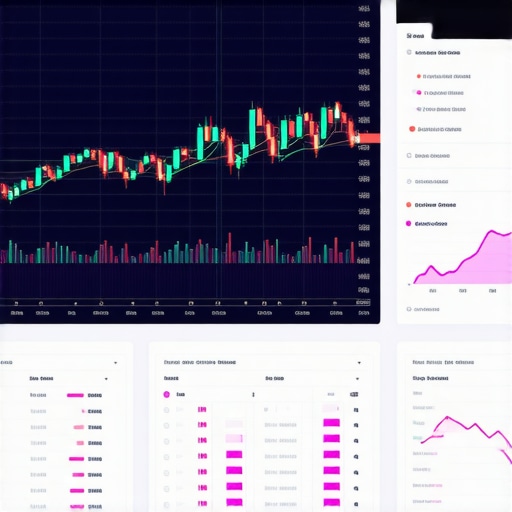Unlocking the Strategic Potential of Gold Futures in 2025: A Deep Dive into Technical Analysis
As global markets become increasingly volatile, gold futures stand out as a sophisticated instrument for savvy investors aiming to optimize their portfolio. Leveraging technical analysis in this context provides a granular understanding of price movements, enabling traders to anticipate trends with higher precision. This article explores advanced strategies for maximizing your returns on gold futures in 2025, grounded in a thorough analytical framework.
Why Gold Futures Are a Critical Component of Modern Portfolio Diversification
Gold futures offer leverage, liquidity, and the ability to hedge against macroeconomic uncertainties. In 2025, with inflationary pressures persisting and geopolitical tensions influencing markets, gold’s role as a safe haven is more pronounced. Combining futures trading with technical analysis allows investors to capitalize on short-term price swings while maintaining a long-term strategic outlook.
Decoding Market Sentiment with Advanced Technical Indicators
Effective analysis hinges on understanding complex indicators such as Relative Strength Index (RSI), Moving Average Convergence Divergence (MACD), and Fibonacci retracement levels. These tools help in identifying entry and exit points with a high degree of confidence. For instance, a MACD divergence may signal an impending trend reversal, enabling traders to position themselves advantageously before a significant price move.
How Macro-Determinants Shape Gold Futures in 2025: An Analytical Perspective
Beyond technical signals, it is crucial to consider macroeconomic factors such as central bank gold purchase policies, inflation expectations, and currency fluctuations. Recent studies, like those published in the Journal of Financial Markets, highlight how shifts in global economic policies can drastically alter gold’s futures trajectory. Integrating these insights with technical analysis enhances predictive accuracy.
What Are the Most Effective Technical Strategies for Gold Futures in a Volatile Market?
In highly volatile environments, employing a combination of trend-following and mean-reversion techniques can yield optimal results. Adaptive strategies, such as dynamic stop-loss orders and real-time chart pattern recognition, are vital for mitigating risks and capturing gains in fast-moving markets. Regularly reviewing market indicators and adjusting positions accordingly is essential for sustained success.
Investors should also explore diversified approaches by incorporating gold ETFs and physical gold assets to balance risk. For a comprehensive understanding of how to diversify effectively, visit this guide on gold investment diversification.
As the landscape evolves, staying informed about market drivers and future trends remains paramount for strategic decision-making. Experts recommend continuous learning and adaptation to refine your technical analysis toolkit.
To deepen your expertise and share insights, consider consulting authoritative sources such as the IMF’s latest research on gold price drivers.
Harnessing Quantum Technical Analysis for Gold Futures in 2025
As markets evolve, investors are increasingly turning to innovative analytical techniques to gain an edge. Quantum computing, though still in nascent stages, promises to revolutionize technical analysis by processing vast datasets at unprecedented speeds. Imagine deploying quantum algorithms to analyze multi-dimensional market indicators simultaneously, uncovering subtle patterns invisible to traditional methods. While still emerging, integrating these advanced tools could significantly refine your prediction models for gold futures in 2025.
Challenging Assumptions: Is Gold Still a Safe Haven Amid Digital Asset Growth?
Many assume gold will always serve as a reliable hedge against economic turmoil. However, the rise of digital assets like cryptocurrencies challenges this notion. While gold’s tangible nature and historical stability provide confidence, recent research from institutions such as the World Gold Council suggests a nuanced relationship between gold and digital assets. Diversification strategies should consider the shifting landscape, blending traditional safe havens with emerging digital investments to optimize resilience.
The Role of Geopolitical Risks in Shaping 2025 Gold Futures Prices
Geopolitical tensions, including trade disputes and regional conflicts, continue to influence market sentiment. In 2025, geopolitical risk assessments are more complex, driven by rapid technological developments and shifting alliances. Analyzing these factors through geopolitical risk indices, such as those published by the Global Risk Insights, can provide actionable intelligence. Incorporating these insights into your trading framework enhances the robustness of your forecasts.
How Can Traders Leverage Machine Learning to Predict Short-Term Gold Futures Movements?
Machine learning algorithms excel at identifying nonlinear patterns in market data, making them invaluable for short-term forecasting. By training models on historical price data, macroeconomic indicators, and sentiment analysis, traders can generate probabilistic predictions of price swings. Tools like neural networks and support vector machines are increasingly accessible through platforms such as futures trading strategies. Continuous model refinement, informed by real-time data, allows for dynamic adjustment in volatile markets.
For a deeper dive, explore how integrating these techniques with traditional technical analysis can yield a comprehensive trading approach.
If you’re interested in practical applications, consider reading about safe gold investment practices to complement your trading strategies.
To stay ahead in 2025, keep a close eye on emerging market trends and expert analyses from authoritative sources like the IMF’s recent research.
Integrating Artificial Intelligence and Big Data Analytics into Gold Futures Forecasting
As the financial landscape becomes increasingly complex, the integration of artificial intelligence (AI) and big data analytics is revolutionizing how traders approach gold futures. Sophisticated machine learning models, such as recurrent neural networks (RNNs) and deep learning architectures, can process vast datasets encompassing macroeconomic indicators, geopolitical developments, and market sentiment in real-time, offering unparalleled predictive accuracy.
These AI-driven tools enable traders to identify subtle market signals that traditional analysis might overlook. For example, sentiment analysis derived from social media and news sources can be quantified and incorporated into predictive models, providing a nuanced understanding of market psychology. According to a recent paper published in the Journal of Financial Data Science, the fusion of big data with machine learning algorithms has demonstrated a significant improvement in short-term gold price forecasting accuracy, especially during periods of heightened volatility.
How does sentiment analysis enhance gold futures prediction accuracy?
Sentiment analysis captures market mood by quantifying emotional responses expressed through news headlines, social media posts, and financial reports. When integrated into machine learning models, sentiment scores can act as leading indicators, signaling potential trend reversals or acceleration. For instance, a surge in negative sentiment related to geopolitical tensions could precede a spike in gold futures prices, allowing traders to position themselves proactively.
Investors interested in leveraging these advanced analytical methods should explore platforms offering AI-powered trading signals and consult authoritative research, such as the work by the IMF’s recent analysis on gold market drivers.
Real-time Data Visualization and Dynamic Risk Management Tools
In volatile markets, static analysis is insufficient. Dynamic, real-time data visualization tools—such as heat maps, live candlestick charts, and custom dashboards—are essential for maintaining situational awareness. These tools facilitate rapid decision-making by illustrating market conditions at a glance, highlighting critical support and resistance levels, and enabling swift adjustments to trading positions.
Furthermore, integrating these visualizations with automated risk management protocols—like trailing stop-loss orders and adaptive position sizing—can mitigate downside risk while maximizing profit potential. Advanced traders often employ algorithmic trading systems that respond instantaneously to predefined market triggers, thus capitalizing on fleeting opportunities with precision.
For traders seeking to deepen their expertise, developing personalized dashboards using platforms like Bloomberg Terminal or MetaTrader 5 can provide a customized, high-fidelity view of market dynamics. These tools empower traders to stay ahead of rapid market shifts and refine their strategies in real time.
Analyzing the Impact of Macro-Financial Policies on Gold Futures in 2025
Macroeconomic policies, including central bank interest rate decisions, quantitative easing measures, and fiscal stimulus programs, exert profound influence on gold futures prices. Recent policy shifts, such as the Federal Reserve’s approach to inflation control, can alter the dollar’s strength and, consequently, gold’s appeal as a hedge.
According to the World Gold Council, a comprehensive understanding of monetary policy trajectories is crucial for effective forecasting. For instance, aggressive rate hikes tend to strengthen the dollar, exerting downward pressure on gold prices, whereas accommodative policies often have the opposite effect.
Investors should monitor policy announcements through official statements and economic calendars, integrating this macroeconomic intelligence with technical signals for a holistic trading approach. Combining these insights with predictive models refined by AI enhances the robustness of forecasts.
What are the most effective ways to incorporate macroeconomic policy analysis into technical trading frameworks?
One effective approach involves developing a multi-layered model that overlays macroeconomic indicators—such as interest rates, inflation rates, and currency indices—onto technical chart analyses. Machine learning algorithms can weigh these factors dynamically, adjusting trading signals based on evolving policy landscapes. This integration ensures that traders remain responsive to macro trends while executing precise technical entries and exits.
For further guidance, consider resources like the latest market analysis reports and expert commentaries that synthesize macroeconomic and technical insights.
Harnessing the Power of Multi-Dimensional Market Data for Precision Trading
As market complexities escalate, integrating multi-dimensional datasets—including macroeconomic indicators, geopolitical risk indices, and sentiment analysis—becomes essential for sophisticated traders. Utilizing platforms that combine real-time data feeds with advanced analytical tools enables the formulation of predictive models with unparalleled granularity, paving the way for highly informed decision-making in gold futures trading.
The Role of Sentiment-Driven Algorithms in Short-Term Gold Price Forecasting
Sentiment analysis, powered by natural language processing (NLP), deciphers market psychology from social media, news outlets, and financial reports. When embedded within machine learning frameworks, sentiment scores act as leading indicators, often signaling imminent trend reversals or accelerations. For example, a surge in negative sentiment surrounding geopolitical instability can precede upward momentum in gold futures, offering traders a strategic edge.
How Can Quantum Computing Revolutionize Technical Analysis of Gold Futures?
Emerging quantum algorithms promise to revolutionize market analysis by processing multi-layered datasets at unprecedented speeds. These techniques facilitate the simultaneous evaluation of complex, non-linear market relationships, uncovering subtle patterns invisible to classical methods. Early research from institutions like MIT suggests that quantum-enhanced models could dramatically improve the accuracy of short-term price predictions, especially amid high volatility.

Integrating Macro-Financial Policy Signals for Dynamic Trading Strategies
Informed trading in 2025 necessitates a nuanced understanding of macro-financial policies, including central bank rate adjustments, fiscal stimulus measures, and quantitative easing programs. These policies exert profound influence on currency valuations and inflation expectations, directly impacting gold futures. Sophisticated traders deploy dynamic models that incorporate macroeconomic data streams, adjusting their strategies in real time to evolving policy landscapes.
Advanced Risk Management through Real-Time Visualization Technologies
Utilizing cutting-edge visualization tools—such as interactive heat maps, live candlestick dashboards, and AI-powered alerts—enables traders to maintain acute situational awareness. These tools facilitate rapid response to market shifts and support the implementation of automated, adaptive risk mitigation protocols, including trailing stops and position sizing algorithms. Such integration ensures resilience and agility in turbulent markets.
The Future of Gold Futures Trading: Combining AI, Big Data, and Expert Intuition
The convergence of artificial intelligence, big data analytics, and human expertise heralds a new era in gold futures trading. Advanced neural networks, trained on diverse datasets, can generate probabilistic forecasts with high precision. Incorporating macroeconomic forecasts, geopolitical risk assessments, and sentiment metrics into these models creates a holistic predictive framework, vastly outperforming traditional analysis in both accuracy and timeliness.
What Are the Best Practices for Developing a Holistic, Multi-Source Trading Model?
Developing an effective multi-source trading model involves integrating diverse data streams—macro indicators, sentiment scores, technical signals—into a unified analytical environment. Employing ensemble machine learning techniques enhances robustness, while continuous model retraining ensures adaptability to market dynamics. Engaging with specialized analytics platforms and collaborating with data scientists can significantly elevate your strategy’s sophistication. For further insights, consult the latest research from the IMF’s recent report on gold market drivers.
Expert Insights & Advanced Considerations
Market Synchronization and Algorithmic Precision
Leveraging high-frequency trading algorithms and multi-dimensional data integration provides a competitive edge in gold futures. Incorporating real-time macroeconomic and geopolitical data enhances predictive accuracy, enabling precise timing of entry and exit points.
Innovative Risk Management Techniques
Adopting adaptive risk management strategies, such as dynamic position sizing and real-time portfolio rebalancing, helps mitigate market volatility. Utilizing advanced visualization tools facilitates swift decision-making and preserves capital during turbulent periods.
Holistic Portfolio Diversification
Integrating gold futures with diversified assets like digital gold, ETFs, and physical holdings ensures resilience against market shocks. A strategic blend tailored to macroeconomic trends optimizes long-term wealth preservation.
Emerging Technologies and Market Analytics
Quantum computing and AI-driven sentiment analysis are poised to revolutionize market forecasting. Staying abreast of technological advancements enhances analytical depth, providing a strategic advantage in 2025.
Strategic Macro-Policy Monitoring
Deep analysis of central bank policies, fiscal measures, and international trade dynamics informs tactical adjustments. Incorporating macroeconomic indicators into algorithmic models enables proactive responses to policy shifts.
Curated Expert Resources
- World Gold Council: Provides authoritative market reports and insights on global demand and supply trends.
- IMF’s Research Publications: Offers in-depth macroeconomic analyses impacting gold prices and investment strategies.
- Financial Data Science Journals: Present cutting-edge research on AI, big data analytics, and market prediction models.
- Bloomberg Terminal & MetaTrader 5: Essential tools for real-time data visualization and customized trading dashboards.
- Academic Institutions (MIT, Stanford): Leading research on quantum computing applications in financial modeling.
Final Expert Perspective
Harnessing the full potential of gold futures in 2025 demands a synthesis of advanced technical analysis, emerging technologies, and macroeconomic intelligence. Staying informed, adaptable, and innovative positions traders to capitalize on market opportunities with confidence. Engage with these expert resources to deepen your strategic acumen and refine your approach—your future success hinges on it. For those committed to mastery, continuous learning and collaboration with industry leaders will unlock new horizons in gold trading.









